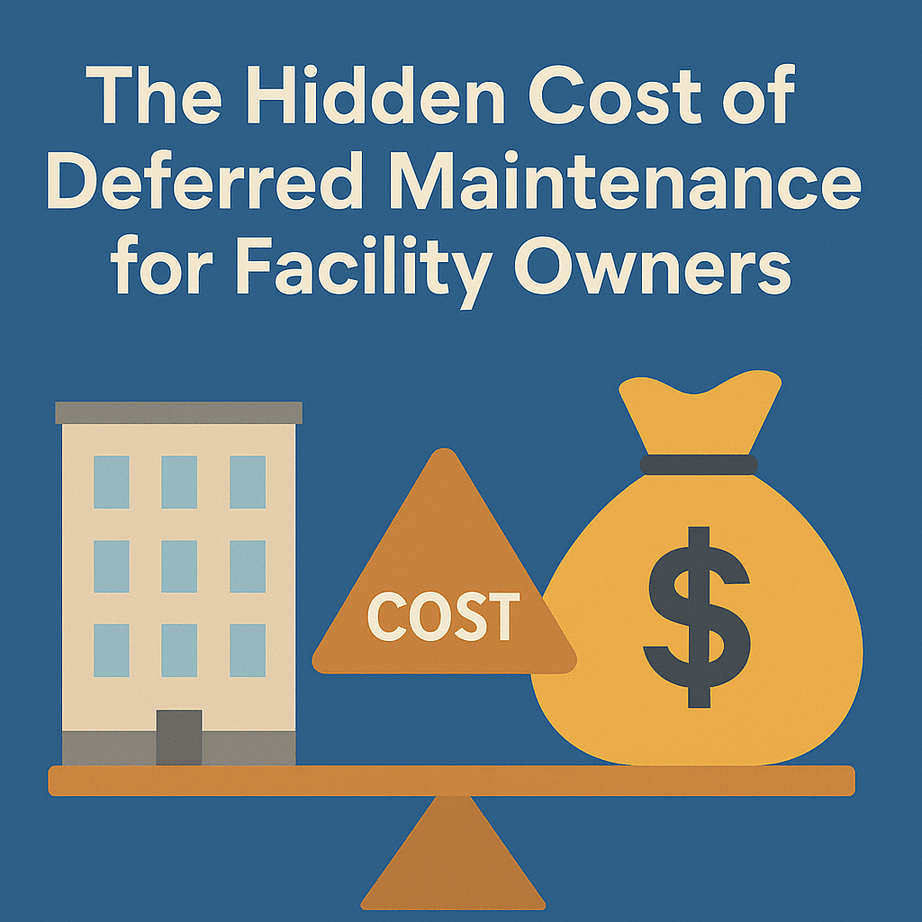Facility maintenance isn’t just a line item in the budget—it’s the foundation of a building’s health, performance, and longevity. Yet, many facility owners fall into the trap of deferring maintenance, assuming it will save money in the short term. In reality, postponing regular upkeep often leads to larger, more expensive problems that could have been avoided with timely action.
In this article, we’ll explore the true financial and operational impact of deferred maintenance, why short-term savings often backfire, and how proactive maintenance strategies protect both assets and bottom lines.
Understanding Deferred Maintenance
Deferred maintenance refers to delaying or postponing routine repairs, inspections, or replacements due to budget constraints or competing priorities. While it may seem harmless at first—fixing what’s broken later rather than now—each delay compounds future costs.
Think of it like ignoring a small leak in the roof. Over time, that minor issue can lead to water damage, mold growth, and structural deterioration, turning a few hundred-dollar repair into a multi-thousand-dollar renovation.
The False Promise of Short-Term Savings
Facility managers are often under pressure to reduce operational costs, and maintenance budgets are easy targets. However, deferring maintenance doesn’t eliminate the expense—it simply delays it while allowing the underlying problems to worsen.
Hidden Costs Include:
- Accelerated Equipment Failure:
Equipment that isn’t serviced regularly—like HVAC systems, pumps, or boilers—faces increased wear and tear. A unit that might have lasted 20 years could fail in half the time if filters, belts, or lubrication schedules are ignored. - Energy Inefficiency:
Dirty coils, clogged filters, or uncalibrated systems force equipment to work harder. The result? Higher energy bills, reduced efficiency, and environmental impact. - Emergency Repairs:
Unplanned breakdowns almost always cost more than scheduled maintenance. Emergency service calls can cost up to five times more than preventive ones, especially after hours or during peak seasons. - Occupant Disruption:
When key systems fail—like heating, cooling, or lighting—tenant satisfaction drops, impacting lease renewals and brand reputation for commercial owners.
The Domino Effect on Asset Value
Deferred maintenance doesn’t just affect day-to-day operations—it erodes the long-term value of your property. A poorly maintained facility signals neglect, making it less attractive to investors, tenants, or buyers.
Over time, building systems degrade faster, leading to compounding issues across structural, mechanical, and electrical components. Appraisers and inspectors often flag deferred maintenance as a risk, reducing property valuations by 10–20% or more.
How Deferred Maintenance Impacts Safety and Compliance
Beyond financial loss, safety and regulatory compliance are at stake. Neglecting fire suppression systems, electrical inspections, or elevator maintenance doesn’t just violate standards—it puts lives at risk.
- Fire Hazards: Dust buildup in electrical panels or HVAC systems can ignite under load.
- Air Quality Issues: Poor ventilation and dirty filters lead to sick building syndrome, affecting employee health and productivity.
- Code Violations: Skipping required inspections or certifications can result in hefty fines, shutdowns, or legal liability.
The Data Behind Preventive Maintenance ROI
Numerous studies confirm what experienced facility managers already know: preventive maintenance delivers one of the best returns on investment in building operations.
- According to the U.S. Department of Energy, every $1 spent on preventive maintenance saves $4 in future repairs.
- Buildings with structured maintenance programs report 15–20% lower utility costs.
- Facilities that adopt predictive maintenance (using IoT sensors and smart analytics) extend equipment life by 20–40%.
These numbers highlight the reality that maintenance isn’t a cost—it’s an investment in reliability, performance, and asset longevity.
Case in Point: A Real-World Example
Consider a manufacturing facility that decided to defer chiller maintenance to “save” $8,000. Within two years, the unit’s performance degraded significantly, causing production line downtime worth $120,000 in lost output and emergency replacements.
What seemed like a smart short-term cut became a massive financial setback, not counting labor costs, energy loss, and customer dissatisfaction.
How to Break the Cycle of Deferred Maintenance
Eliminating deferred maintenance requires a strategic and data-driven approach. Here’s how we guide facility owners and managers toward long-term efficiency and savings:
1. Conduct a Facility Condition Assessment (FCA)
Identify, prioritize, and document all existing maintenance issues. This provides a baseline for budgeting, scheduling, and long-term asset management.
2. Implement a Preventive Maintenance Program
Create standardized schedules for all mechanical, electrical, and plumbing systems. Use maintenance management software (CMMS) to track service history and automate reminders.
3. Adopt Predictive Maintenance Technology
Smart sensors and IoT tools enable real-time monitoring of system performance, helping identify potential failures before they occur.
4. Prioritize High-Risk Assets
Focus on critical systems that affect safety, comfort, and core operations—like HVAC, boilers, and electrical panels.
5. Budget for the Future, Not the Present
Reframe maintenance as capital protection rather than a recurring cost. Allocate contingency funds for proactive maintenance rather than reactive repair.
The Leadership Perspective: Why Decision-Makers Should Care
Executives and property owners must recognize that maintenance is directly tied to operational resilience. When maintenance is neglected, it doesn’t just create costs—it undermines brand trust, disrupts business continuity, and increases liability exposure.
A facility that runs efficiently communicates reliability and professionalism to clients, tenants, and employees alike. Leadership that prioritizes preventive care inspires confidence and protects the organization’s reputation.
The Bottom Line: Deferred Maintenance Is a Silent Budget Killer
What begins as a cost-saving strategy often ends as a financial burden. The hidden cost of deferred maintenance can exceed the original expense many times over, especially when considering energy inefficiency, asset devaluation, safety risks, and emergency downtime.
In a world where operational performance and sustainability are key differentiators, regular maintenance is not optional—it’s essential.
Conclusion
Deferred maintenance is the enemy of efficiency, safety, and profitability. Facility owners who choose proactive care gain not only financial advantages but also peace of mind, knowing their assets are protected for the long term.
Investing in regular service today ensures a more sustainable, efficient, and resilient tomorrow—and that’s the smartest business decision any facility owner can make.


